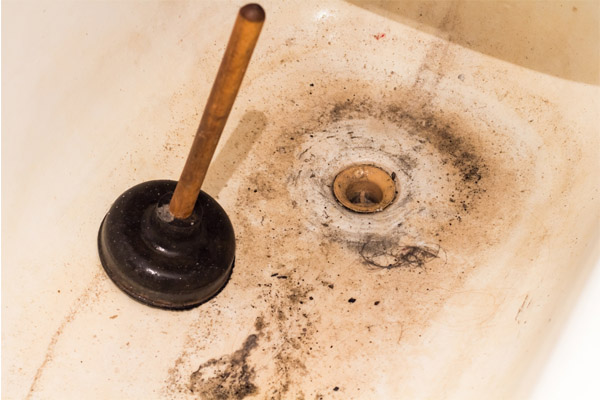Deciphering the Mystery of Discharge in the Bathtub
Deciphering the Mystery of Discharge in the Bathtub
Blog Article
The author is making a number of great pointers related to What To Do If Sewage Starts Backing Up Into the Shower as a whole in the article just below.

Sewage backup in the tub can be a distressing and unsanitary trouble for any kind of homeowner. Not just is it bothersome, yet it likewise presents severe health dangers and suggests underlying concerns with the plumbing system. Comprehending why sewage is turning up through the bath tub is critical for taking appropriate action to resolve the trouble efficiently.
Intro to the Problem
Recognizing the Trouble
When sewer draws back up into the bath tub, it's a clear indication of an issue with the water drainage system. The wastewater that needs to be flowing far from your home is rather finding its back right into your space, which can lead to considerable damage and carcinogen.
Possible Reasons
A number of factors can add to sewer back-up in the bath tub. From obstructions in the sewage system line to issues with the plumbing framework, identifying the source is necessary for finding a solution.
Usual Reasons for Sewer Back-up
Obstructions in the Sewer Line
One of the most typical causes of sewage back-up is a clog in the drain line. This can take place as a result of the accumulation of particles, grease, or foreign objects in the pipelines, avoiding proper flow and causing sewer to support right into your bath tub.
Tree Origin Invasion
Tree origins looking for dampness and nutrients can penetrate drain lines through little fractures or joints. Over time, these origins can expand and expand, creating considerable damages to the pipelines and resulting in sewage back-up problems.
Aging Infrastructure
Older homes might have dated plumbing systems that are a lot more at risk to rust, fractures, and degeneration. As pipes age, they become more prone to leaks and blockages, boosting the possibility of sewage backup occurrences.
Heavy Rainfall or Flooding
During periods of heavy rainfall or flooding, the sewer system may end up being overloaded with excess water, creating back-ups and overflows. This can lead to sewer supporting right into bathtubs and various other fixtures inside the home.
Health Dangers Connected With Sewage Back-up
Contamination of Water System
Sewer backup can pollute the supply of water in your house, posing a significant wellness threat to you and your family members. Direct exposure to contaminated water can lead to gastrointestinal problems, skin infections, and other illnesses.
Spread of Illness
Sewage contains dangerous microorganisms, viruses, and parasites that can create a series of illness, consisting of liver disease, cholera, and gastroenteritis. Entering contact with sewage or contaminated surface areas puts you at risk of infection.
Mold and mildew Growth
Dampness from sewage backup can create ideal problems for mold and mildew development in your home. Mold spores can worsen breathing troubles and create allergic reactions in delicate people, making punctual cleanup important.
Signs of Sewer Back-up
Foul Odors
Unpleasant smells emanating from drains pipes or components, especially in the bathroom, may show sewage back-up problems. These smells are usually strong and persistent, signaling a problem that needs prompt attention.
Slow Draining Fixtures
Bath tubs, sinks, and commodes that drain pipes gradually or not in all could be experiencing sewage backup. If numerous fixtures are influenced at the same time, it's likely that the problem stems from a typical factor, such as the primary sewer line.
Gurgling Sounds
Weird gurgling or bubbling sounds originating from drains when water is running elsewhere in your home are indicative of air caught in the plumbing system. This air buildup can arise from sewage backup and need to be explored immediately.
Immediate Actions to Take
Turning Off Water Supply
In the event of sewage backup, it's important to switch off the supply of water to prevent further contamination and damage. Find the primary water shutoff valve in your home and closed it off up until the concern can be fixed.
Getting In Touch With a Professional Plumber
Managing sewage back-up is not a DIY work. Get in touch with a certified plumber with experience in taking care of sewage-related issues to analyze the situation and do needed repair services or cleanings.
Staying Clear Of Contact with Polluted Water
Up until the sewer backup is fixed, avoid contact with polluted water to prevent the spread of microorganisms and microorganisms. Put on safety gear if you more info should remain in the afflicted area and clean your hands extensively later.
Safety nets
Routine Maintenance of Sewage System Lines
Schedule normal evaluations and upkeep of your drain lines to determine and resolve potential concerns prior to they escalate right into significant problems. This can include cleaning particles, evaluating for tree origin invasion, and fixing any type of damaged pipes.
Installing Backwater Valves
Consider setting up bayou shutoffs in your plumbing system to stop sewer from flowing back into your home during durations of heavy rainfall or flooding. These shutoffs automatically close when water draws back up, safeguarding your building from contamination.
Proper Disposal of Home Waste
Prevent flushing anything besides toilet tissue and human waste down the bathroom to avoid clogs and blockages in the sewer line. Dispose of oil, oil, and other household chemicals correctly to decrease the threat of plumbing troubles.
Cleaning Up After Sewage Back-up
Sanitation Procedures
Completely decontaminate and sanitize affected areas after sewer backup to eliminate hazardous bacteria and protect against mold and mildew development. Use appropriate cleaning items and safety gear to make certain risk-free and reliable cleanup.
Reconstruction of Affected Areas
Repair any damage to floor covering, wall surfaces, or components triggered by sewer back-up. Relying on the level of the damage, you may need to change carpets, drywall, or various other products to restore your home to its pre-loss condition.
Why Is Water Backing Up in My Bathtub When I Flush My Toilet?
What to do about a sewer line clog
First, don’t bother with plunging. No amount of plunging will dislodge the clog in a sewer line. The clog is too far away. Plungers are for clogs in the toilet itself, not the sewer line. Plus, the most likely causes of a sewer clog are:
Tree roots Flushed toys or feminine products Grease buildup Those items don’t move easily. And in the case of tree roots, the roots need to be cut out of the pipe and the pipe will need to be repaired.
You’ll need a closet auger. A closet auger is a type of plumber’s snake with a protective cover to keep from scratching the delicate porcelain toilet. If the clog is further down, you may need to remove the toilet or use one of your cleanouts to get to the clog.
We also recommend doing a video inspection of the drain to ensure that the cause of the clog has been completely removed. Otherwise, you could have the same problem again in a few days or weeks.
https://mspplumbingheatingair.com/blog/why-is-water-backing-up-in-my-bathtub-when-i-flush-my-toilet

As an enthusiastic person who reads about , I was thinking sharing that section was worthwhile. Don't hesitate to set aside a second to promote this content if you appreciated it. We appreciate reading our article about Water Coming up Bathtub Drain.
Click Here
Report this page